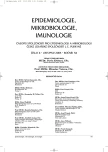Antibody Response to Ascaris lumbricoides among the Children Population in the Ústí Region
Authors:
J. Richter; I. Stiborová; J. Pohořská; L. Dobiášová; V. Král
Authors‘ workplace:
Zdravotní ústav se sídlem v Ústí nad Labem
Published in:
Epidemiol. Mikrobiol. Imunol. 54, 2005, č. 4, s. 143-147
Overview
A group of 156 children aged between 10 and 12 years were screened for IgG and IgE antibodies to Ascaris lumbricoides. The study subjects were 64 children of Romany origin and 92 children from the majority population. IgG antibodies to Ascaris lumbricoides were detected in 112 (71.8 %) children. No difference in the prevalence of IgG antibodies was found between Romany children and those from the majority population. As many as 34.1 % of the study subjects had IgE antibodies to Ascaris lumbricoides, again with no difference between the two ethnic groups. Children with IgG antibodies to Ascaris lumbricoides had significantly higher total IgE levels compared to those who had tested IgG negative. To demonstrate induction of a non-specific IgE response was one of the study objectives. The high prevalence rates of IgG and IgE antibodies to Ascaris lumbricoides are suggestive of a high frequency of cross- and non-specific reactions. Possible effect of cross-reactivity to other antigens on the specific IgG and IgE antibody response to Ascaris lumbricoides is discussed.
Key words:
Ascaris lumbricoides – IgG antibodies – IgE antibodies – prevalence – total IgE.
Labels
Hygiene and epidemiology Medical virology Clinical microbiologyArticle was published in
Epidemiology, Microbiology, Immunology

2005 Issue 4
Most read in this issue
- Mortality of Drug Users. Summary of Cohort Study Results.
- Antibody Response to Ascaris lumbricoides among the Children Population in the Ústí Region
- Biological characteristics of Plesiomonas shigelloides strains of human and animal origin
- Foams as Disinfectant Carriers
